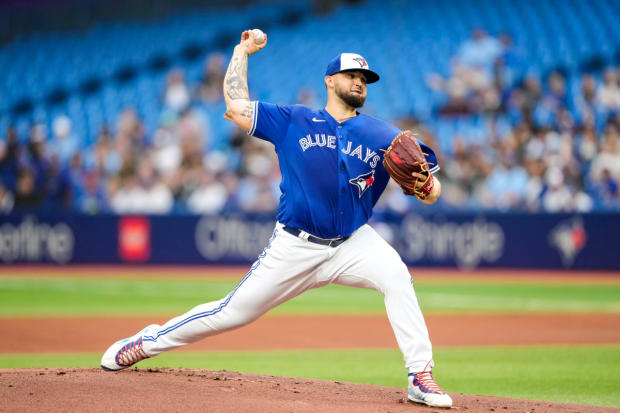View the original article to see embedded media.
Welcome to The Opener, where every weekday morning during the regular season you’ll get a fresh, topical story to start your day from one of SI.com’s MLB writers.
Neither Alek Manoah nor his slider are showing any signs of a sophomore slump.
Through 15 starts in 2022, Manoah has a 9–2 record and a 2.09 ERA, good for third in the American League. And the righthander’s numbers have shown remarkable consistency since his rookie year. After pitching just 35 innings in the minors he was called up in 2021 and cemented himself in the Toronto rotation, seemingly without much of an adjustment period.

Kevin Sousa/USA TODAY Sports
How and why has he found success so quickly? Perhaps it’s his warmup routine, which involves tossing a football around on game days. The much more likely reason? His slider.
Manoah’s sweeping slider has a significant amount of glove-side movement that jams lefties and buckles righties. Batters are hitting .174 against the pitch this year. It also has a 31.1% whiff rate.
According to Statcast data, Manoah’s slider is averaging 15.6 inches of horizontal movement this season. When compared to MLB sliders thrown at similar velocities, that’s 5.3 inches, or 52%, more movement than average. In his rookie season, Manoah’s slider averaged 15.5 inches of horizontal break, ranking 16th out of 370 qualifying MLB sliders.
By contrast, Manoah’s 94 mph four-seam fastball averages 5.5 inches of horizontal movement, about 21% below average for similar MLB pitches. Manoah likes to play his four-seamer off of his slider—combined, he throws them 67.6% of the time. His slider comes in at 81.2 mph. The change in speed combined with the nasty break can help explain why even when batters do get a hold of the pitch, they only have a .257 slugging percentage and a 17.7% hard-hit rate.
Rounding out his arsenal, Manoah’s sinker and changeup both have an average amount of arm-side movement.
Manoah isn’t afraid to throw inside; it’s one of the reasons he had the most HBPs in the AL last year with 16. He’s currently tied for most in the AL this year, too, with six. The hit batters don’t necessarily signify control issues—his walk rate of 5.1% ranks in the 88th percentile of MLB pitchers. Against right-handed batters, he tends to open up the outer half of the plate by beginning the plate appearance with an inside four-seamer or sinker, and then serves a slider that drops off the outside edge of the strike zone. Hitters might adjust to the inside fastball by backing off the plate or by speeding up their barrel, which can then make it difficult to stay back on his offspeed pitches on the outside corner later in the plate appearance. Just take a look at these two pitches from the same first-inning plate appearance against White Sox first baseman José Abreu on June 2.
Watch Manoah and the Blue Jays all season long with fuboTV: Start a 7-day trial today!
Manoah vs. Abreu: 4-Seam Fastball, 0–0 Count
Manoah vs. Abreu: Slider, 1–2 Count
That night, he went 7 2/3 innings in an 8–3 Blue Jays win. He allowed three runs, six hits and one walk. Four of his five strikeouts came via his slider.
Manoah has fared far better against right-handed hitters than lefties, who are batting .266 against him this season, compared with the .152 average he’s allowed to righties. Opposing teams are starting to take advantage of these splits; the Yankees put five left-handed batters in their lineup in their win over Manoah and the Jays on June 18. The trouble has mostly come from Manoah’s four-seamer, with lefties slugging .464 against the pitch this season. Manoah’s slider is his way of neutralizing left-handed hitters, but it’s also a risky offering, because there is less room for error. Because Manoah’s slider breaks toward lefties, they can more easily track its trajectory out of his hand, and barrel it up if it is left out over the plate. When the slider starts in the strike zone and darts down and in toward lefties and then out of the zone, it can be a devastating pitch. So far, that’s mostly been the case. Lefties are batting .189 against Manoah’s slider, while righties have a .167 average when facing it.
The slider came to form while Manoah was still in college. Pitching in the Cape Cod Baseball League in between seasons at West Virginia University and unsatisfied with his changeup, he decided that he needed to add a breaking ball to his arsenal. Manoah refined his grip by watching videos by Rob Friedman, also known as Pitching Ninja, on YouTube.
Manoah knows he can rely upon his slider as a wipeout pitch, or in moments when he needs to throw a strike. He turns to it 40% of the time when he’s in a two-strike count, and 26.2% of the time in a three-ball count.
Toronto knows it can rely on Manoah’s slider, too. The young righthander and his nastiest pitch will be crucial for the Blue Jays if they are going to fulfill their high preseason expectations and make a deep postseason run.







